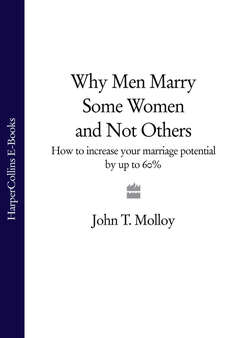Читать книгу Why Men Marry Some Women and Not Others: How to Increase Your Marriage Potential by up to 60% - John Molloy T. - Страница 7
The First to Test the Research
ОглавлениеAlmost two years to the day after Kelly had started the research, she called to tell me she was getting married. She had followed the guidance she had gleaned from her own research. She had found a new man she was crazy about, but she had not let him treat her the way the first two men did. Kelly also reported that her sister, Robin, had just become engaged, and she thought the reason she had no problem getting her boyfriend to commit was that she had also used my report as her guide. That was nine years ago.
In October 1993, the next stage of the research had its beginning when another young woman, Karen, confronted me in the hallway of a company where I was running training sessions in nonverbal sales techniques. She complained that my report on getting married—which was being passed around without my permission—did not answer all the questions she had. Karen indignantly pointed out that, according to the report, there’s a certain time in most relationships when men are most likely to commit—but the report never explained when that occurs. She was outraged that I thought there were stages in relationships but had not bothered to identify them. “Don’t you think you have an obligation to find out?” she demanded.
This irate young woman also wanted to know if, after several dates, a bright woman could tell if a man was a prospective husband or an immature clown. When Karen paused for breath, I asked her if she had a copy of the report. Without missing a beat, she pulled one from her purse. I explained that the report was only a research summary, hoping this would get her to back off. Instead, Karen asked if I would design a survey to answer her questions. I had her sign the agreements necessary if I ever wanted to include the research in a book, but the real reason I went along with her proposal was that she was one of my star pupils in the sales course, and I wanted to keep her happy.
I promised to develop the survey on three conditions. First, only the people who attended my sales sessions could conduct the survey. Second, she and her friends could not talk about what we were doing. Third, the research procedure must be followed exactly as designed, and no one could make changes without my permission. She immediately agreed to all my conditions, and I designed a small survey that would answer most of her questions. I agreed, as I had with Kelly, that after she finished the project, I would take the raw data and summarize it.
A couple of months later, this second group turned in their survey results. Not trained researchers, they hadn’t done as good a job as Kelly’s group; in fact, some of their questioning was rather sloppy. Nevertheless, they had come up with some interesting information. When I combined their data with the first study, it turned out to be one of those times when one plus one added up to more than two. The research also raised more questions than it answered, but I still never thought it would become a book.
Once word got out that I had such a report, almost every unmarried woman who worked for me and hundreds of their friends asked to read it. Some even reviewed the raw data. At least thirty groups of female researchers volunteered to conduct additional surveys if I would analyze the data they collected. I refused all but two of these offers, because I began to see a potential book and knew I had to control all future research. I spent three months in the field developing the final version of the marriage license bureau surveys.
I was aware of the “rose-colored-glasses” effect and considered it when interpreting the data. When interviewing couples who’d just picked up marriage licenses, asking them to describe the person with whom they intended to spend the rest of their lives, I expected their descriptions to be unrealistic. If there was any moment in their lives when they were going to look at their mates through rose-colored glasses, this would be it. It’s the old “I-bought-it” factor. If you ask people shopping for their first minivan which one is the best on the market, most will say they aren’t sure. Even those who have decided which minivan they intend to buy are likely to qualify their answers. But if you ask the same respondents the same question after they have just purchased a van, most will tell you the one they own is the best.
